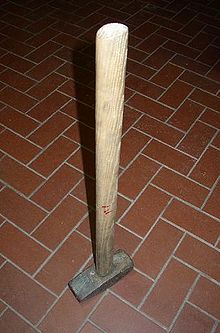Sledge hammer
A sledgehammer , also called Mottek , Bello , Jakob, Jackl, Lehmann or Maker , is a hand tool consisting of a hammer head , also known as a head , and a handle . Because of the weight of his head of 5 kg and more, he is guided with both hands and is mainly used for rough work.
History and characteristics
Sledge hammers were already being used in stone quarrying and processing in Roman times . Even then, the head was made of forged iron , and its shape was also very similar to that which is common today.
A sledgehammer has a square track (name for the flat end of the hammer) and a fin that runs across the handle (name for the wedge-shaped end of the hammer). The fin of sledgehammers is often rounded. If it runs in the direction of the handle, the sledge hammer is called a cross hammer .
The stonemason's setting hammer , which has a beveled and sharp-edged fin, is a special form of the cross- hammer . So in this case it is a cutting edge.
In Germany, the DIN standard 1042 specifies the following dimensions for sledge hammers:
- Head weight: 5 to 15 kg
- Handle length: 60 to 120 cm
Modern models, especially abroad, have an octagonal head cross-section or an even more complex head shape. The track is then designed to be octagonal or round.
use
Sledge hammers are used in quarries or in the building trade , but primarily in the forge . In the construction industry, sledgehammers are used because of the high impact force and are used for smaller demolition work or driving in strong nails or bolts.
In metalwork Vorschlag- and cross hammers in addition to the groups of the one-handed form hand hammers , as well as auxiliary hammers , such as the shot hammer for separating, the group of two-handed supplement hammers .
To forge in twos or threes, is with a sledgehammer looked up : The first Schmied ( Vorschmied ) holds the workpiece with one hand either to the rod (ie, a non-heated part of the semi-finished product) or with a pair of pliers on the anvil, twists and turns if necessary, and with a hand hammer in the other hand sets the so-called clock to the knockers. Clock setting means that the Vorschmied by proposing with the hand hammer to the other, with sledgehammer working Smith ( Zuschläger ) start and end of slamming, breakdown location, thickness, and displaying speed and, fin or rail shock.
During forging, every blow of the hammer on the red-hot steel displaces part of it from the impact area. When striking with the hammer track, the material is displaced evenly in all directions, whereas with those with the fin, it is mainly perpendicular to it. If the metal is to be displaced forwards and backwards, the blacksmith therefore leads a sledge hammer with a fin across the handle; if, on the other hand, it is to be displaced laterally from the striking plane, then he takes a cross hammer with a fin in the direction of the handle. The fin on the forge hammer is rounded and has no sharp edge, because otherwise it could accidentally sever the forged material.
In contrast to other work with the hammer, when forging you hold the two-handed sledgehammer “upside down”; the weaker side hand - i.e. the left hand in the case of right-handed people - stops at the far end of the handle, while the stronger main hand is close to the hammer head so that the blow is set with greater precision. You don't get any momentum over your head, but just guide the hammer in a slight arc from top to bottom.
Others
Although a sledge hammer is not an everyday object, it is still very well known. In common parlance, the image of the sledgehammer or that of slamming with the sledgehammer is used for a procedure with extreme force or even a complete lack of consideration.
Individual evidence
- ↑ Article in the Hamburger Abendblatt from January 20, 2007
- ↑ Seaman's Lexicon. In: Große-seefahrt.de. Retrieved August 11, 2018 .
- ↑ Building materials and construction machinery of the Romans. In: restena.lu. Retrieved April 8, 2014 .
- ↑ Roman highlights from Augusta Raurica: Sledgehammer. In: kgv.bl.ch. Retrieved April 8, 2014 .
- ↑ Hermann Hundeshagen: The blacksmith at the anvil. A practical textbook for all blacksmiths . Verlag Th.Schäfer, Hannover 2001, ISBN 3-88746-430-3 , pp. 27 ff., 44 ff.


